History
Rise and fall from 17th to 19th century
Between 1551 and 1554, what became known as the Moritzbastei was built as a bastion in Leipzig's walls under the supervision of the mayor Hieronymus Lotter. In 1547, Elector Moritz of Saxony directed the reconstruction of the town fortifications of Leipzig after they became largely destroyed during the Smalkaldic War between German Emperor Charles V and the Smalkaldic League. The bastion was named after Elector Moritz.
In 1642, during the Thirty Years War, the Moritzbastei was stormed. During the Seven Years' War (1756–1763), it lost its military function. Henceforth it served as a store for trade goods and workplace for a bell founder and a book printer.
From 1796 to 1834, Leipzig's first public school was built over the basement of the Moritzbastei by architect Johann Carl Friedrich Dauthe. It was the first school in Germany without confessional segregated classes.
Rise again in the 20th century
The school was destroyed in 1943 during World War II. Rubble and remains of the destroyed building were filled into the basement rooms of the bastion.
In 1973/1974 Leipzig University students discovered the remains of the Moritzbastei and persuaded the university and city authorities to allow it to be rebuilt as a student club. More than 30,000 students were engaged in the reconstruction of the bastion, among them the future Chancellor of Germany, Angela Merkel. From 1982, the Moritzbastei was the official student club of Leipzig University run by the Free German Youth as a venue for encounter and cultural events.
In 1993 the Moritzbastei ceased being part of Leipzig University and became a legally independent (commercial) foundation. It is still linked to the university through its board of directors which is headed by the Rector of Leipzig University. A second board member has to be an elected student representative.
Since 1993, the Moritzbastei has been run in the form of a GmbH under licence of the Moritzbastei foundation as a cultural centre. Its main purpose is to foster and sustain the student and academic culture in Leipzig.
The Board of Trustees, which oversees the work of the foundation without institutional subvention, consists of one representative of the city of Leipzig, the Free State of Saxony and the student body.
In recent years artists from all over the world have been guests of the Moritzbastei.
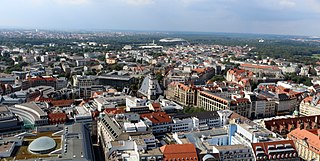
Leipzig is the most populous city in the German state of Saxony. The city has a population of 628,718 inhabitants as of 2023. It is the eighth-largest city in Germany and is part of the Central German Metropolitan Region. The name of the city means "linden tree place" and is, like the names of most of Leipzig's districts and geographical features, of Slavic origin.

Saxony, officially the Free State of Saxony, is a landlocked state of Germany, bordering the states of Brandenburg, Saxony-Anhalt, Thuringia, Bavaria, as well as the countries of Poland and the Czech Republic. Its capital is Dresden, and its largest city is Leipzig. Saxony is the tenth largest of Germany's sixteen states, with an area of 18,413 square kilometres (7,109 sq mi), and the sixth most populous, with more than 4 million inhabitants.

Dresden is the capital city of the German state of Saxony and its second most populous city after Leipzig. It is the 12th most populous city of Germany, the fourth largest by area, and the third most populous city in the area of former East Germany, after Berlin and Leipzig. Dresden's urban area comprises the towns of Freital, Pirna, Radebeul, Meissen, Coswig, Radeberg and Heidenau and has around 790,000 inhabitants. The Dresden metropolitan area has approximately 1.34 million inhabitants.
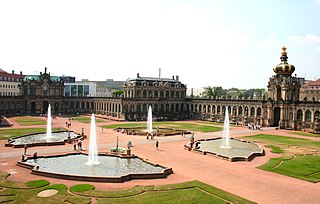
The Zwinger is a palatial complex with gardens in Dresden, Germany. Designed by architect Matthäus Daniel Pöppelmann, it is one of the most important buildings of the Baroque period in Germany. Along with the Frauenkirche, the Zwinger is the most famous architectural monument of Dresden.

Halle (Saale), or simply Halle (German:[ˈhalə]; from the 15th to the 17th century: Hall in Sachsen; until the beginning of the 20th century: Halle an der Saale ; from 1965 to 1995: Halle/Saale) is the largest city of the German state of Saxony-Anhalt, the fifth-most populous city in the area of former East Germany after (East) Berlin, Leipzig, Dresden and Chemnitz, as well as the 31st-largest city of Germany, and with around 244,000 inhabitants, it is slightly more populous than the state capital of Magdeburg. Together with Leipzig, the largest city of Saxony, Halle forms the polycentric Leipzig-Halle conurbation. Between the two cities, in Schkeuditz, lies Leipzig/Halle International Airport. The Leipzig-Halle conurbation is at the heart of the larger Central German Metropolitan Region.
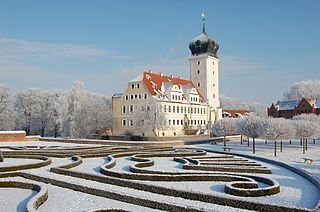
Delitzsch is a town in Saxony in Germany, 20 km north of Leipzig and 30 km east of Halle (Saale). With 24,850 inhabitants at the end of 2015, it is the largest town in the district of Nordsachsen.
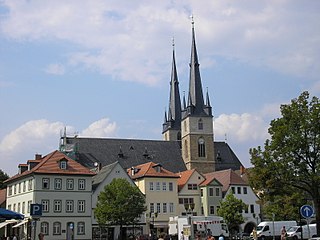
Saalfeld is a town in Germany, capital of the Saalfeld-Rudolstadt district of Thuringia. It is best known internationally as the ancestral seat of the Saxe-Coburg and Gotha branch of the Saxon House of Wettin.

Naumburg is a town in the district Burgenlandkreis, in the state of Saxony-Anhalt, Central Germany. It has a population of around 33,000. The Naumburg Cathedral became a UNESCO World Heritage Site in 2018. This UNESCO designation recognizes the processes that shaped the European continent during the High Middle Ages between 1000 and 1300: Christianization, the so-called "Landesausbau" and the dynamics of cultural exchange and transfer characteristic for this very period.
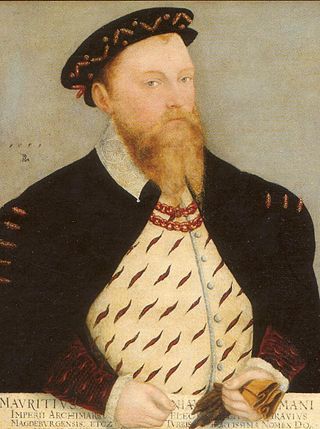
Maurice was Duke (1541–47) and later Elector (1547–53) of Saxony. His clever manipulation of alliances and disputes gained the Albertine branch of the Wettin dynasty extensive lands and the electoral dignity.

Brühl's Terrace is a historic architectural ensemble in Dresden, Germany. Nicknamed "The Balcony of Europe", the terrace stretches high above the bank of the river Elbe, and is located north of the recently rebuilt Neumarkt Square and the Frauenkirche.

The St. Thomas Church is a Lutheran church in Leipzig, Germany, located at the western part of the inner city ring road in Leipzig's central district. Martin Luther preached in the church in 1539. It is associated with several well-known composers, especially Johann Sebastian Bach, who was its Thomaskantor from 1723 until his death in 1750. The church holds his remains.
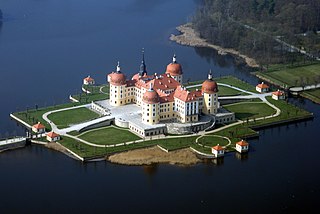
Moritzburg Castle or Moritzburg Palace is a Baroque palace in Moritzburg, in the German state of Saxony, about 13 kilometres (8.1 mi) northwest of the Saxon capital, Dresden. The castle has four round towers and lies on a symmetrical artificial island. It is named after Duke Moritz of Saxony, who had a hunting lodge built there between 1542 and 1546. The surrounding woodlands and lakes were a favourite hunting area of the electors and kings of Saxony.

The Moritzburg is a fortified castle in Halle (Saale), Germany. The cornerstone of what would later become the residence of the Archbishops of Magdeburg was laid in 1484; the castle was built in the style of the Early Renaissance.

The Pleissenburg was a historical building in the city of Leipzig in Saxony which is in modern-day Germany. It was built in the 13th century by the Margrave Dietrick and named after the river Pleisse which runs nearby. Martin Luther gave the first evangelical sermon in the castle chapel on Pentecost Sunday in 1539.

Leipzig University Library, known also as Bibliotheca Albertina, is the central library of the University of Leipzig. It is one of the oldest German university libraries.

Köllnischer Park is a public park located near the River Spree in Mitte, Berlin. It is named after Cölln, one of the two cities which came together to form Berlin; the park location was originally just outside it. Approximately 1 hectare in area, the park came into existence in the 18th and 19th centuries on the site of fortifications. It was redesigned as a public park in 1869–1873 and was further modified in the 20th century with the addition of first a bear enclosure, the Bärenzwinger, and later a permanent exhibition of sculpture, the Lapidary. The park is a registered Berlin landmark.
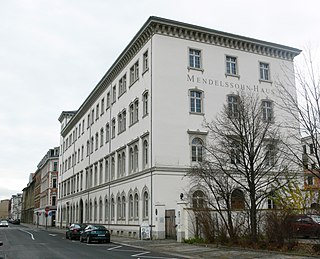
Mendelssohn House is a museum in Leipzig in Saxony, Germany. The composer Felix Mendelssohn lived here from 1845 until his death in 1847; it now contains a collection about the life and work of the composer.
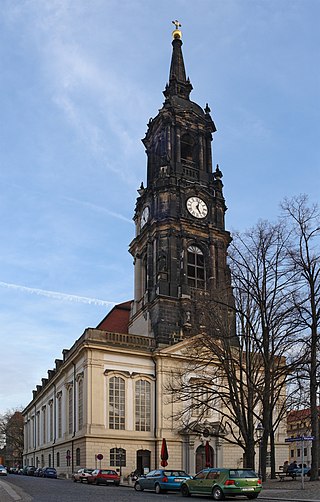
The Dreikönigskirche is a Lutheran church located in the Innere Neustadt of Dresden, Germany. It is the centre of a parish, and a community venue called Haus der Kirche. The church is a listed cultural monument of Dresden.
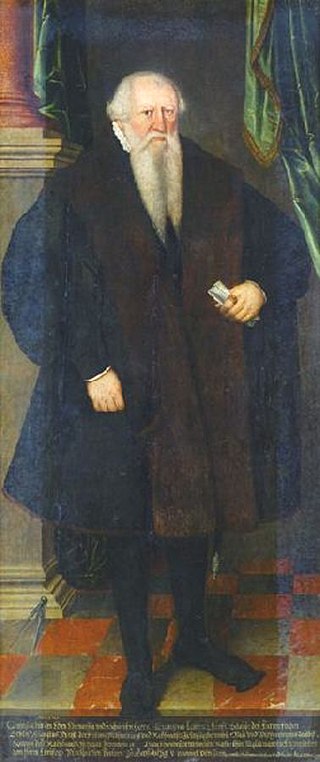
Hieronymus Lotter was a merchant and several times mayor of Leipzig, construction manager for important sovereign building projects in Saxony and the driving force behind extensive building measures by the municipal council in Leipzig. Lotter was the Master builder of Maurice, Elector of Saxony, under the direction of the principal toolmaster and master builder Caspar Vogt von Wierandt. According to earlier research, he was considered an important architect of the Renaissance; today its role is seen in a more differentiated way and above all its organizational function is emphasized.

The Promenadenring Leipzig is the oldest municipal landscape park in Germany and one of the most important garden and cultural monuments in the city. The term is also used as a synonym for Leipzig's inner city ring road, a traffic facility that is connected to the green spaces of the Promenadenring. Like the inner city ring road, the promenade ring is about 3.6 kilometers long (2.24 mi.).





















